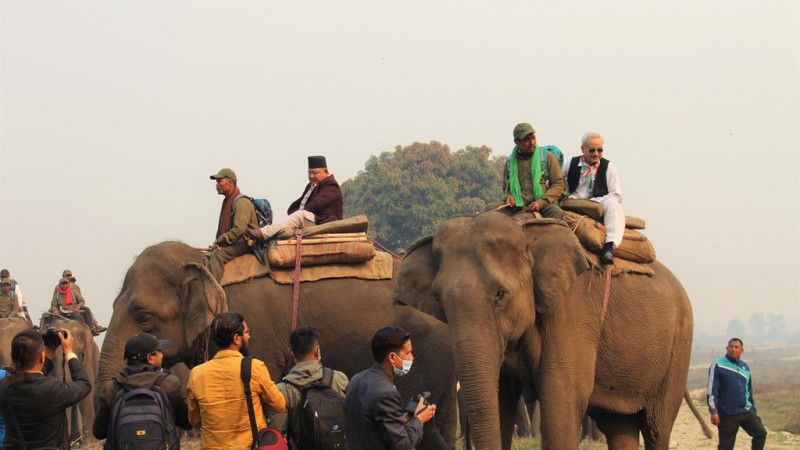
The National Rhino Count 2021 has begun from yesterday on 22 March. Over the next one month Nepal will count and update its rhino population status. The counting will set off from the Chitwan-Parsa complex gradually covering all the four rhino-bearing national parks of Nepal (Parsa, Chitwan, Bardia and Shuklaphanta) and adjoining forests/grasslands. The last census in 2015 had established Nepal's greater one-horned rhinoceros population at 645 individuals, with 605 rhinoceros in Chitwan National Park, 29 in Bardia National Park, 8 in Shuklaphanta National Park and 3 in Parsa National Park and their adjoining forests. Previously five national rhino counts have been conducted in 1994, 2000, 2008, 2011 and 2015.
The greater one-horned rhinoceros is listed as a protected animal by National Parks and Wildlife Conservation Act (1973) and is also listed in CITES Appendix-I since 1975. The Department of National Parks and Wildlife Conservation (DNPWC) and the Department of Forests in partnership with NTNC, WWF Nepal, ZSL Nepal and local communities conduct rhino counts every 4 to 5 years to find out the population status and evaluate the effectiveness of management interventions. With no more than 3500 one-horned rhinos estimated in the wild, Chitwan National Park holds the second largest one-horned rhino population in the world after Kaziranga National Park in Assam, India.
Population trend of greater one-horned rhinoceros in Chitwan Valley and Nepal (source: DNPWC)
The census is being led by the Department of National Parks and Wildlife Conservation (DNPWC) with additional financial and technical support from conservation stakeholder organizations NTNC, WWF Nepal, and ZSL Nepal. NTNC's member secretary Mr. Sharad Chandra Adhikary expressed pride and happiness over the government's strong willingness to undertake the important task despite the testing times, and in NTNC's primary role for providing frontline technical and logistical backup throughout the counting assignment. Last year the Government of Nepal had allocated NPR 11 million in funds for the counting operation that had to be postponed due to the COVID-19 situation.
To implement this national-level operation, the Chitwan National Park area has been divided into 19 blocks which will be surveyed one after another. A total of 42 elephants and 200 persons, comprising of rhino enumerators, management support staff, and elephant shelter teams will be deployed in Chitwan and Parsa for the next 21 days, this is in addition to 60 persons and nine elephants to be deployed in Bardia for about 10-12 days, and 40 persons and five elephants in Shuklaphanta for about a week. Some 4770 person-days equivalent of human resources is expected to be deployed overall. Trained teams mounted on elephant backs will traverse through rhino habitat blocks counting and recording individual rhinos in a standard format.
Two days of orientation training has already been conducted in Sauraha this weekend for 72 enumerator participants and 120 elephant support personnel before setting afoot for the Chitwan-Parsa counting. Training participants including assistant conservation officers, rangers, game scouts and technicians were cued on aspects related to ensuring elephant walking line control maintenance and management, rhino identification, datasheet and recordkeeping, GPS and map handling, code of conduct, among others. Similar trainings are planned to be conducted in Bardia on 31 March and in Shuklaphanta on 01 April. The census findings are expected to be announced by the third week of April.
Marking the initiation of the counting event, the Minister for Forests and Environment Hon. Prem Bahadur Ale started proceedings with a traditional forest goddess worship ritual from the Ramauli Pratappur area of Parsa National Park. Following this an official launching ceremony was organized at the NTNC-Biodiversity Conservation Centre (NTNC-BCC) premises in Sauraha, where among others in company were Hon. Minister Ale, member of the National Planning Commission Dr Krishna Prasad Oli, MOFE Secretary Dr Bishwa Nath Oli, district coordination committee chiefs, local-level government chiefs, district-level security chiefs, Park focused Nepal Army battalion commanders, buffer zone management committees, community forest user groups, conservation stakeholder entities, hotel entrepreneurs, nature-guide association members, and media persons.

